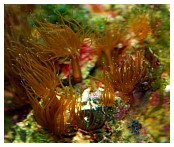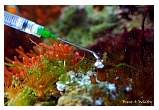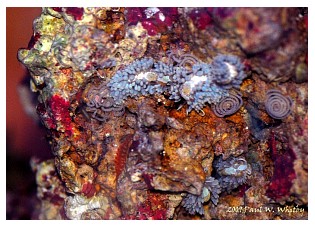 Reefkeeping 101
Reefkeeping 101
Reefkeeping 101
Pests, Parasites And Things That Go Munch In The Night, Part 1
Introduction
At some time in all of our reefkeeping careers we will encounter one or more pests in our systems that we will have to take measures to eradicate. The advanced aquarists have learned through bitter experience what to look for and how to keep nuisances at bay. For a person new to the hobby this is a different matter. In writing this article I want to try to illustrate what to look for, both the symptoms and the culprit, and give an idea on how to manage these invaders. Many are easy to deal with- and after reading this article you may decide that some are worth the hassle since it allows you to keep the biological control. Some nuisances you need to avoid at all costs and knowing what to look for on new corals can save you a great deal of time, money and most of all- frustration. This quick guide is only part of the story and before you begin on any eradication program I strongly suggest you read, read and read more about the problem and what you can do to overcome it. With that being said, let's look at the commonly encountered pests.
Public Enemy Number One: Aiptasia
Aiptasia are small brown anemone-like creatures with an amazing resilience to bad water conditions, low light and just about every other extreme a new aquarist could subject their tank to. If it wasn't for the fact that they reproduce like crazy and can overrun a tank, as well as being plain ugly, they would be the ideal beginner coral as they are almost impossible to kill. It is this amazing growth capability that makes these the most frequently encountered problem in marine systems.
 |
 |
 |
| Aiptasia heavily infest this tank belonging to the author. As you can see, the base of the nuisance anemone is often hidden in a crevice, thereby making their removal a difficult task. |
Eradication
Aiptasia can be eradicated by a number of methods, both chemically and biologically. Both work well and have advantages and disadvantages associated with them. The chemical based methods are very effective and fast, however, you can only kill the Aiptasia you can see - and more importantly reach. There are several compounds on the market that effectively kill these nuisances and each has to be applied directly to the Aiptasia itself. Most of the products are a thick white paste that adheres to the Aiptasia’s body and literally dissolves it. Several of the commercial products come with specially shaped applicators allowing easy access to the body. While the death of the offending Aiptasia is quick, it is impossible to treat every Aiptasia since some will be in cracks and crevices, while juveniles will be too small to see. This necessitates vigilance and the knowledge that further eradications will be required.
 |
 |
 |
 |
| Using an applicator, the Aiptasia eradication compound can be gently applied to the body. Almost immediately, the Aiptasia begins to melt until nothing is left. The amount of time lapsed in these photos is approximately 10 minutes. |
An alternative to chemical control is biological. There are three main weapons we can use: the Copperband butterflyfish (Chelmon rostratus), Peppermint shrimp (Lysmata wurdemanii) and Berghia nudibranchs (Berghia verucornis). Each of these biological weapons have their own issues attached and as such the aquarist should seek the one that suits them best. Of them all, the peppermint shrimp is most likely the easiest to acquire and the fastest to begin eradicating Aiptasia. Peppermints are small red shrimp and should not be confused with the Camel shrimp, which looks very similar. The distinguishing features of peppermint shrimp are the presence of pale red striping on the body and predominantly red legs. The Camel shrimp has a more vivid color and white legs, as well as a raised hump on the back, giving it its name. The rostrum of the Camel shrimp (the 'beak" of the shrimp) is bright red on the Camel and white on the Peppermint.
 |
 |
 |
| Notice the paler color of the Peppermint shrimp when compared with the Camel shrimp. Also note their different leg colors and the bright red line on the rostrum of the Camel shrimp. Peppermint shrimp (left) courtesy of Gary Majchrzak; Peppermint shrimp (middle) courtesy of John Susibilla; Camel shrimp (right) courtesy of Greg Rothschild. |
The Peppermint shrimp is commonly available in most local stores and are relatively easy to keep. They are, like all shrimp, scavengers and will perform as part of the cleanup crew. They do however have a taste for Aiptasia. Following addition of a small group to a tank the Aiptasia will slowly begin to disappear, usually overnight, as the shrimp are nocturnal. Not all shrimp will eat Aiptasia and it is advisable to purchase a small group for your tank. The number depends very much on the tank size and the number of Aiptasia but ideally a group of 6 in a 100 gallon tank is fine. One cautionary word is that like all other shrimp, their tastes may change overtime and they may begin to eat other corals such as zoanthids and other polyps so be prepared to remove them should problems arise.
Copperband butterfly fish are often regarded as one of the best methods of Aiptasia eradication, not only is the fish beautiful, but it has a great appetite for Aiptasia. In last month's issue of Reefkeeping there was an extensive profile of this fish, which can be accessed here and as such I will not add more. Quoting from that article, "Many aquarists have found this to be hit and miss, with some fish voraciously attacking Aiptasia, while others ignore it all together. They do find ornamental feather dusters and any fan/tube worms to be quite tasty and will clear an aquarium of these inhabitants in no time. " This is also my experience with this fish. I have had several that seek out Aiptasia while others totally ignore it and as such I strongly recommend buying a fish that has shown this behavior at the store, or from a fellow hobbyist. Sadly, these fish may not fare well in the long term, though some survive for many years.
The final biological weapon at our command is the small nudibranch, Berghia verucornis (photo below). These are available from numerous online vendors and are extremely useful in eradicating all Aiptasia, be they small, large or completely hidden inside rockwork.
 |
Berghia nudibranchs are commonly sold as young adults, at about 1 cm in length. They are small and white with a darker furry-looking set of appendages on either side of their body. They are obligate feeders on Aiptasia, which means that they will eat only Aiptasia and will starve without this food item. Since they are so small, they do take a long time to eradicate a tank of the nuisance anemones, but with planning and forethought Berghia can wipe a tank clean in a few months. Should you choose Berghia as your method of choice, you should follow this simple plan. Find an online vendor that can ship you 4 or 5 adult specimens and have prepared a 10-gallon tank with fresh saltwater in it. The tank requires no heating or light nor even water flow - though I add a simple airline bubbling slowly to agitate the water. Add to this tank several Aiptasia from the main system. Ideally, these should be scraped from the tank side with a blade to avoid adding any rocks which may harbor bristle worms and other tank fauna which may eat the Berghia. On the day of arrival, slowly acclimate the Berghia to the new tank and add them to an area away from the Aiptasia. Then stand back and let nature take its course. Within a few days you will notice the Aiptasia disappearing as well as small spiral ribbons of white eggs appearing. As the Aiptasia are consumed, add more to keep the adults fed and inside a month you will notice lots of subadults moving over the tank bottom and sides.
 |
 |
As these approach 1 cm in length they can be carefully removed using a turkey baster and transferred to the main tank. When doing this, be very careful when capturing them as they are extremely delicate. Add the Berghia, in the dark, to an area near Aiptasia in the main tank. Do not add them directly to an Aiptasia as it is likely that the Aiptasia will eat the Berghia and not the other way around. They newly added nudibranchs will almost instantly disappear into the rocks where they will hide from predators such as wrasses. At night, however, they will come out and search for Aiptasia which they rapidly consume. It is likely that the nudibranchs will fall prey to some tank creature over time and some will be consumed by powerheads. However, the breeding colony will continually be able to supply the main tank with many young adults for months and months. I follow this method and have successfully treated many tanks with this approach.
|
While I am a personal advocate of biological control, a methodology utilizing both chemical and biological treatment is a great way to attack this problem. The Copperband butterfly is one of my favorite fish, and I actively seek to grow Aiptasia on rocks in my refugium with which to feed him. I am not sure if Aiptasia are his favorite food, but he certainly cleans any small rock that I add to the tank that has a few of these nuisances on. Growing Berghia as I described above is a great project and can readily supply many young nudibranchs to members of a local club. One thing to note is that the young nudibranchs are extremely hungry, and you will be hard pressed to feed enough Aiptasia to keep a colony going for very long - especially after the main tank is receiving juveniles. In this month's Reefkeeping the fish profile features the Melanurus wrasse. Like all of the commonly available wrasses, these fish will actively seek nudibranchs to eat, which is good, since many nudibranchs prey on Montipora corals and zoanthids. If your tank is heavily populated with wrasses, you may need to add more Berghia, or choose another method.
Whichever method you choose to deal with Aiptasia, research thoroughly the pros and the cons of the approach. Determine if the approach is suitable for your system and be aware of the potential problems you may encounter, and how to deal with those problems.
In the next installment of "Pests, Parasites and Things That Go Munch in the Night," I will be looking at a few more organisms that can reach pest proportions in our systems - Asterina starfish and various flatworms. You can also read about flatworms in this month's magazine here.
If you have any questions about this article, please visit my author forum on Reef Central.



